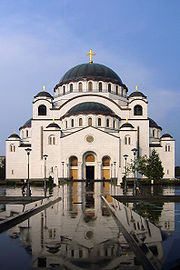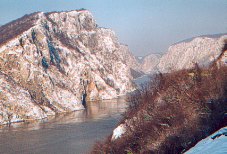
Seven Wonders of Serbia
Encyclopedia
The Seven Wonders of Serbia are the seven historical and cultural monuments of Serbia
, which were chosen in the Seven Wonders of Serbia contest held in 2007 and 2008. It was organized by Politika Magazin
, while main patron of the contest was Tourist Organisation of Serbia.
Serbia
Serbia , officially the Republic of Serbia , is a landlocked country located at the crossroads of Central and Southeast Europe, covering the southern part of the Carpathian basin and the central part of the Balkans...
, which were chosen in the Seven Wonders of Serbia contest held in 2007 and 2008. It was organized by Politika Magazin
Politika
Politika is a Serbian newspaper. It is considered the newspaper of record and is the oldest daily in the Balkans, having been founded on January 25, 1904 by Vladislav Ribnikar. It is currently being published by Politika Newspapers and Magazines , a joint venture between Politika AD and...
, while main patron of the contest was Tourist Organisation of Serbia.
Lists
Contest separated two lists of seven wonders. One is known as "Seven Serbian Wonders of Construction", equivalent of Seven Wonders of the World, while other one is called "Seven Serbian Wonders of Nature", , equivalent of Seven Natural Wonders of the World.Seven Serbian Wonders of Construction
The seven wonders comprise:| Wonder | Date of construction | Builder | Notable features | Image |
|---|---|---|---|---|
| Belgrade Fortress | 535 AD | Justinian I Justinian I Justinian I ; , ; 483– 13 or 14 November 565), commonly known as Justinian the Great, was Byzantine Emperor from 527 to 565. During his reign, Justinian sought to revive the Empire's greatness and reconquer the lost western half of the classical Roman Empire.One of the most important figures of... |
Pobednik Pobednik Statue of the Victor or Statue of Victory is a monument in the Kalemegdan fortress in Belgrade, erected on 1928 to commemorate the Kingdom of Serbia's war victories over Ottoman Empire and Austria-Hungary . It is one of the most famous works of Ivan Meštrović. Name od Statue represent Victory of... monument |
|
| Šargan Eight Šargan Eight The Šargan Eight is a narrow-gauge heritage railway in Serbia, running from the village of Mokra Gora to Šargan Vitasi station. An extension to Višegrad in the Republika Srpska, Bosnia and Herzegovina, was finished on 28 August 2010.... |
15. January 1925 | Serbian Railways Serbian Railways Serbian Railways is the national railway carrier of Serbia. Its current network spans a distance of 4,347 km in length, with 32% electrified railways.... |
Drvengrad Drvengrad Drvengrad , also known as Küstendorf and Mećavnik , is a traditional village that the Serbian film director Emir Kusturica built for his film Life Is a Miracle. It is located in the Zlatibor District near the city of Užice, two hundred kilometers southwest of Serbia's capital, Belgrade... , a traditional village that the Serbian Serbs The Serbs are a South Slavic ethnic group of the Balkans and southern Central Europe. Serbs are located mainly in Serbia, Montenegro and Bosnia and Herzegovina, and form a sizable minority in Croatia, the Republic of Macedonia and Slovenia. Likewise, Serbs are an officially recognized minority in... film director Emir Kusturica Emir Kusturica Emir Nemanja Kusturica , is a Serbian filmmaker, actor and musician, recognized for several internationally acclaimed feature films... had built for his film Life Is a Miracle Life Is a Miracle Life is a Miracle is a Serbian drama film directed by Emir Kusturica in 2004. It was entered into the 2004 Cannes Film Festival.-Plot:... . |
|
| Studenica monastery Studenica monastery The Studenica monastery is a 12th-century Serbian Orthodox monastery situated 39 km southwest of Kraljevo, in central Serbia. It is one of the largest and richest Serb Orthodox monasteries.... |
1196 | Stefan Nemanja Stefan Nemanja Stefan Nemanja was the Grand Prince of the Grand Principality of Serbia from 1166 to 1196, a heir of the Vukanović dynasty that marked the beginning of a greater Serbian realm .He is remembered for his contributions to Serbian culture and... |
Monument of Culture of Exceptional Importance Monuments of Culture of Exceptional Importance (Serbia) Cultural Monuments of Exceptional Importance are the monuments in the Republic of Serbia that have the highest level of the State protection, and some of them are part of the UNESCO World Heritage Sites.... and UNESCO World Heritage Site |
 |
| Gamzigrad Gamzigrad Gamzigrad is an archaeological site, spa resort and UNESCO World Heritage Site of Serbia, located south of the Danube river, near the city of Zaječar. It is the location of the ancient Roman complex of palaces and temples Felix Romuliana, built by Emperor Galerius... |
298 AD | Emperor Galerius Galerius Galerius , was Roman Emperor from 305 to 311. During his reign he campaigned, aided by Diocletian, against the Sassanid Empire, sacking their capital Ctesiphon in 299. He also campaigned across the Danube against the Carpi, defeating them in 297 and 300... |
Roman compound with two temples, two palaces and a building with corridor including exceptionally fine mosaics depicting Greek gods Dionysos and Medusa | |
| Visoki Dečani | 1327 | King Stefan Uroš III Dečanski | UNESCO World Heritage Site, also notable because of a collection of numerous exceptional wall frescoes. | |
| Cathedral of Saint Sava | 1989 | Aleksandar Deroko Aleksandar Deroko Aleksandar Deroko was a famous Serbian architect, artist, and author... Branko Pešić Branko Pešić Branko Pešić was member of the Yugoslav resistance forces during the Yugoslav People's Liberation War, and later leader of the Yugoslav Communist party in Belgrade and Mayor of Belgrade from 1964 to 1974.... |
The church bells are tuned to play "Hymn to Saint Sava", and can be heard in the entire city. |  |
| Subotica Town Hall | 1910 | Marcell Komor Dezső Jakab |
Best known Art Nouveau Art Nouveau Art Nouveau is an international philosophy and style of art, architecture and applied art—especially the decorative arts—that were most popular during 1890–1910. The name "Art Nouveau" is French for "new art"... architecture example in Serbia |
Seven Serbian Wonders of Nature
| Wonder | Notable features | Image |
|---|---|---|
| Drina Drina The Drina is a 346 kilometer long river, which forms most of the border between Bosnia and Herzegovina and Serbia. It is the longest tributary of the Sava River and the longest karst river in the Dinaric Alps which belongs to the Danube river watershed... with spring |
Border between Serbia Serbia Serbia , officially the Republic of Serbia , is a landlocked country located at the crossroads of Central and Southeast Europe, covering the southern part of the Carpathian basin and the central part of the Balkans... and Bosnia and Herzegovina Bosnia and Herzegovina Bosnia and Herzegovina , sometimes called Bosnia-Herzegovina or simply Bosnia, is a country in Southern Europe, on the Balkan Peninsula. Bordered by Croatia to the north, west and south, Serbia to the east, and Montenegro to the southeast, Bosnia and Herzegovina is almost landlocked, except for the... |
|
| Canyon Uvac Uvac The Uvac is the river in southwestern Serbia and Republika Srpska, 119 km long right and major tributary of the Lim, loosely making the northern border of the Sandžak/Raška region... |
Meanders in the nature park. | |
| Đavolja varoš | 202 exotic formations described as earth pyramids or "towers". New Seven Wonders of Nature finalist. | |
| Tara National Park | One of five national parks of Serbia | |
| Đerdap Gorge | Longest and largest Gorge in Europe |  |
| Prerast of Vratna River | Three massive natural stone bridges over the river. | |
| Fruška Gora Fruška Gora Fruška Gora is a mountain in north Syrmia. Most part of the territory is located within Vojvodina, Serbia, but a smaller part on its western side overlaps the territory of Croatia... |
National Park, and home to 16 monasteries built between the 12th and 15th centuries. |  |

